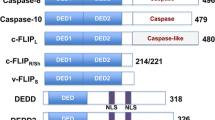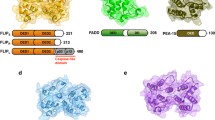Abstract
Cell-death inducing DFF45-like effect domain (CIDE domain) is a protein interaction module that was initially found in DNA fragmentation factor (DFF) proteins DFF40 and DFF45. Several other CIDE-containing proteins, CIDE-A, CIDE-B, and CIDE-3, have since been identified in humans. Although the main function of these proteins is associated with apoptosis, recent studies have identified roles of CIDE-containing proteins in energy metabolism, especially involvement in control of the size of lipid droplets. Because CIDE-containing proteins perform critical tasks in apoptosis and energy metabolism and have been linked to many human diseases including cancer and obesity, studies of CIDE domains and CIDE-containing proteins are of great biological importance. This review summarizes the structural insight into CIDE and the CIDE–CIDE complex and speculates on a generalized strategy for the CIDE–CIDE interaction based on the available CIDE structures and molecular modelling.







Similar content being viewed by others
References
Batistatou A, Greene LA (1993) Internucleosomal DNA cleavage and neuronal cell survival/death. J Cell Biol 122:523–532
Lugovskoy AA, Zhou P, Chou JJ, McCarty JS, Li P et al (1999) Solution structure of the CIDE-N domain of CIDE-B and a model for CIDE-N/CIDE-N interactions in the DNA fragmentation pathway of apoptosis. Cell 99:747–755
Zhou P, Lugovskoy AA, McCarty JS, Li P, Wagner G (2001) Solution structure of DFF40 and DFF45 N-terminal domain complex and mutual chaperone activity of DFF40 and DFF45. Proc Natl Acad Sci USA 98:6051–6055
Liu X, Zou H, Slaughter C, Wang X (1997) DFF, a heterodimeric protein that functions downstream of caspase-3 to trigger DNA fragmentation during apoptosis. Cell 89:175–184
Sakahira H, Enari M, Nagata S (1999) Functional differences of two forms of the inhibitor of caspase-activated DNase, ICAD-L, and ICAD-S. J Biol Chem 274:15740–15744
Sabol SL, Li R, Lee TY, Abdul-Khalek R (1998) Inhibition of apoptosis-associated DNA fragmentation activity in nonapoptotic cells: the role of DNA fragmentation factor-45 (DFF45/ICAD). Biochem Biophys Res Commun 253:151–158
Gu J, Dong RP, Zhang C, McLaughlin DF, Wu MX et al (1999) Functional interaction of DFF35 and DFF45 with caspase-activated DNA fragmentation nuclease DFF40. J Biol Chem 274:20759–20762
Inohara N, Koseki T, Chen S, Wu X, Nunez G (1998) CIDE, a novel family of cell death activators with homology to the 45 kDa subunit of the DNA fragmentation factor. EMBO J 17:2526–2533
Chen Z, Guo K, Toh SY, Zhou Z, Li P (2000) Mitochondria localization and dimerization are required for CIDE-B to induce apoptosis. J Biol Chem 275:22619–22622
Liang L, Zhao M, Xu Z, Yokoyama KK, Li T (2003) Molecular cloning and characterization of CIDE-3, a novel member of the cell-death-inducing DNA-fragmentation-factor (DFF45)-like effector family. Biochem J 370:195–203
Nishino N, Tamori Y, Tateya S, Kawaguchi T, Shibakusa T et al (2008) FSP27 contributes to efficient energy storage in murine white adipocytes by promoting the formation of unilocular lipid droplets. J Clin Invest 118:2808–2821
Lin SC, Li P (2004) CIDE-A, a novel link between brown adipose tissue and obesity. Trends Mol Med 10:434–439
Zhou Z, Yon Toh S, Chen Z, Guo K, Ng CP et al (2003) Cidea-deficient mice have lean phenotype and are resistant to obesity. Nat Genet 35:49–56
Li JZ, Ye J, Xue B, Qi J, Zhang J et al (2007) Cideb regulates diet-induced obesity, liver steatosis, and insulin sensitivity by controlling lipogenesis and fatty acid oxidation. Diabetes 56:2523–2532
Park OK, Park HH (2012) Dual apoptotic DNA fragmentation system in the fly: Drep2 is a novel nuclease of which activity is inhibited by Drep3. FEBS Lett 586:3085–3089
Lee SM, Park HH (2014) In vitro analysis of the complete CIDE domain interactions of the Drep system in fly. Apoptosis 19:428–435
Cotter TG (2009) Apoptosis and cancer: the genesis of a research field. Nat Rev Cancer 9:501–507
Yonezawa T, Kurata R, Kimura M, Inoko H (2011) Which CIDE are you on? Apoptosis and energy metabolism. Mol BioSyst 7:91–100
Otomo T, Sakahira H, Uegaki K, Nagata S, Yamazaki T (2000) Structure of the heterodimeric complex between CAD domains of CAD and ICAD. Nat Struct Biol 7:658–662
Sun Z, Gong J, Wu H, Xu W, Wu L et al (2013) Perilipin1 promotes unilocular lipid droplet formation through the activation of Fsp27 in adipocytes. Nat Commun 4:1594
Lee SM, Jang TH, Park HH (2013) Molecular basis for homo-dimerization of the CIDE domain revealed by the crystal structure of the CIDE-N domain of FSP27. Biochem Biophys Res Commun 439:564–569
Holm L, Sander C (1995) Dali: a network tool for protein structure comparison. Trends Biochem Sci 20:478–480
Lee SM, Park HH (2013) General interaction mode of CIDE:CIDE complex revealed by a mutation study of the Drep2 CIDE domain. FEBS Lett 587:854–859
Park OK, Park HH (2013) A putative role of Drep1 in apoptotic DNA fragmentation system in fly is mediated by direct interaction with Drep2 and Drep4. Apoptosis 18:385–392
Liu X, Zou H, Widlak P, Garrard W, Wang X (1999) Activation of the apoptotic endonuclease DFF40 (caspase-activated DNase or nuclease). Oligomerization and direct interaction with histone H1. J Biol Chem 274:13836–13840
Cort JR, Chiang Y, Zheng D, Montelione GT, Kennedy MA (2002) NMR structure of conserved eukaryotic protein ZK652.3 from C. elegans: a ubiquitin-like fold. Proteins 48:733–736
Huang WC, Ko TP, Li SS, Wang AH (2004) Crystal structures of the human SUMO-2 protein at 1.6 A and 1.2 A resolution: implication on the functional differences of SUMO proteins. Eur J Biochem 271:4114–4122
Reverter D, Lima CD (2005) Insights into E3 ligase activity revealed by a SUMO-RanGAP1-Ubc9-Nup358 complex. Nature 435:687–692
Sato Y, Fujita H, Yoshikawa A, Yamashita M, Yamagata A et al (2011) Specific recognition of linear ubiquitin chains by the Npl4 zinc finger (NZF) domain of the HOIL-1L subunit of the linear ubiquitin chain assembly complex. Proc Natl Acad Sci USA 108:20520–20525
Acknowledgments
This research was supported by a grant from the Korea Healthcare Technology R&D Project, Ministry of Health and Welfare, Republic of Korea (HI13C1449).
Author information
Authors and Affiliations
Corresponding author
Rights and permissions
About this article
Cite this article
Park, H.H. Structural insight into CIDE domains: the Janus face of CIDEs. Apoptosis 20, 240–249 (2015). https://doi.org/10.1007/s10495-014-1067-z
Published:
Issue Date:
DOI: https://doi.org/10.1007/s10495-014-1067-z




